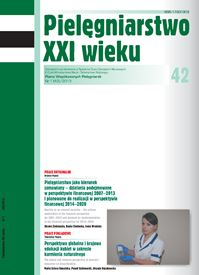The analysis of frequency of heart attacks and interventions of medical rescue teams in Brzesko District in years 2010–2011
Keywords:
heart attack, frequency of heart attack, interventions of medical rescue teamAbstract
THE ANALYSIS OF FREQUENCY OF HEART ATTACKS AND INTERVENTIONS OF MEDICAL RESCUE TEAMS IN BRZESKO DISTRICT IN YEARS 2010–2011
Introduction. Cardiovascular diseases have been the biggest threat to human life for years – in 2006 they made up 46% of all deaths. In recent years there has been a slow decline in cardiovascular mortality rates, which results first and foremost from decreasing risk of ischemic heart disease, particularly of heart attack. Cardiovascular diseases are considerably more frequent cause of premature death of Polish people than of the inhabitants of the other countries in European Union. In 2006, 16% of all patients hospitalized in Poland were cured due to cardiovascular diseases. The decline in the number of deaths caused by heart attack may attest to the more effective interventions with heart attack patients, both in pre-hospital interventions and hospital treatment.
Aim. The aim of the study was to analyze the frequency of heart attacks and interventions of medical rescue teams in Brzesko district in years 2010-2011.
Materials and methods. The retrospective study was conducted in March and April 2012 with the use of the analysis of medical records. The materials of the study involved call cards of ambulance and medical rescue cards. The documentation of medical rescue teams in Brzesko district in 2010 and 2011, consisting of 10,208 emergency call records, was submitted for retrospective analysis. There were isolated 1,082 cards in which the reason of emergency call was cardiovascular affliction. Subsequently, 142 cards were isolated, in which the record confirmed cardiac infarction diagnosis.
Results. The number of all interventions of medical rescue teams in 2011 was higher by 148 than it was in 2010. The median and mean arrival time for ambulances fulfilled the requirements of the act. To the patients with cardiovascular diseases Advanced Life Support ambulances (ALS-S) were sent. The majority of the calls occurred during the day (in the morning and before midday).Every intervention ended with transport of the patient to the nearest ER (Emergency Room) or frequently – to invasive cardiology department. Under the age of 60, heart attack concerns mainly men, over 60 - equally men and women. It occurs much more frequently in patients with cardiological history, also those who suffered from hypertension or diabetes. The interventions of medical rescue team in all cases were accordant with current requirements.
Conclusions.
- The number of medi cal rescue in ter ventions was hi g her in 2011 than in 2010.
- The number of medi cal rescue te ams in terventions due to heart at tack in 2010 and 2011 was comparable.
- The bigger number of patients diagnosed with heart attack was referred directly to invasive cardiology department than to emergency department.
- The procedures applied by medical rescue were in accordance with binding guidelines.
References
1. Wojtyniak B, Goryński P. Sytuacja zdrowotna ludności Polski: Narodowy Instytut Zdrowia Publicznego, Państwowy Zakład Higieny; Warszawa 2008.
2. Kózka M, Kawalec E, Płaszewska- Żywko L. Analiza interwencji zespołu karetki
pogotowia, Zdr Publ 2008; 118 (1): 54-58.
3 Asirifi E. Fundacja rozwoju medycyny ratunkowej. Anest Ratow 2007;1:16-18.
4. Kopeć G, Podolec P. Postępowanie pacjenta a opóźnienie w rozpoczęciu leczenia ostrego zawału serca, Kardiol Pol 2009; 67: 812-816.
5. Wojewódzka- Żelezniakowicz M, Czaban L.S, Chabielska E, Ładny J.R. Ostre zespoły wieńcowe w aspekcie medycyny ratunkowej, Post Nauk Med 2009; 6:474-479.
6. Gaszyński W. S i P, czyli karetki po nowemu – Atest Ratow 2007; 2: 65-69.
7. Ustawa o Państwowym Ratownictwie Medycznym z dnia 8 września 2006, Dz.U.06.Nr.191, poz. 1410 z późniejszymi zmianami.
8. Ziółkowska K, Paciorek P. Czas dojazdu pogotowia ratunkowego na miejsce zdarzenia na przykładzie powiatu i miasta Słupsk, Probl Pielęg 2009; 17 (2): 110-115.
9. Paczek K. Ratownictwo Medyczne – doświadczenia pierwszego roku, Anest Ratow 2007; 3: 151-152.
10. Szyller J. Ostre zespoły wieńcowe w praktyce ratownika medycznego, Na Ratunek 2010; 2:
11. Dudek D, Legutko J, i wsp. Organizacja interwencyjnego leczenia pacjentów z zawałem serca STEMI i NSTEMI w Polsce, Kardiol Pol 2010; 68, 5: 618-624.
12. Zalecenia Wojewody Małopolskiego w sprawie postępowania ze stwierdzonym zawałem mięśnia sercowego dla podmiotów realizujących zadania w zakresie ratownictwa medycznego na terenie województwa małopolskiego z grudnia 2009.
13. Karcz M, Rużyłło W. Bezpośredni transport pacjentów z zawałem serca do pracowni hemodynamicznej z ominięciem najbliższego szpitala po teletransmisji EKG – doświadczenia z programu pilotażowego na Mazowszu, Post Kardiol Interw 2005; 1,2: 107-113.
14. Joachimiak P. Zawał serca -co nowego w pierwszej dekadzie XXI wieku, Anest Ratow 2008; 2: 297-304.
15. Cacko A, Pawlak M, Grafowski M. Postępy w ostrych zespołach wieńcowych, Kardiol na co Dzień 2009; 4 (2): 54-62.
Downloads
Published
Issue
Section
License
Copyright (c) 2013 Małgorzata Urbaniak-Ostrykiewicz, Beata Wilk-Łoboda (Autor)

This work is licensed under a Creative Commons Attribution 4.0 International License.




